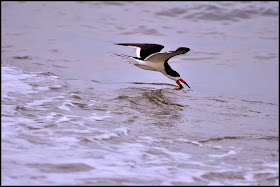A few American oystercatchers were first to land on Wrightsville’s beach strand, kicking off the 2015 nesting season late in March.
The oystercatchers are typically the first shorebirds to nest after pairing off and establishing nesting territory, said Audubon North Carolina Coastal Biologist Lindsay Addison. She expects black skimmers, least terns and common terns to arrive and nest later in April.
“We hope to have the entire cast of characters back this year,” Addison said.
(Bird Stewards post the nesting area on March 30th)
The south end bird habitat, enclosed March 30 to keep nests safe from human disturbance, was home to hundreds of nesting least tern pairs in previous years, but hosted no successful nests in 2014. Six pairs attempted to nest, but Addison attributed the failure to disturbance from marine construction crews dredging sand from Masonboro Inlet to pump on the beach for Wrightsville’s coastal storm damage reduction project.
“We basically lost the entire least tern colony,” Addison said. Because the south end has accreted sand over the past year, providing more open sandy habitat preferred by the birds, Addison said some of the lost least terns should return for the 2015 season. The chicks will fledge, or begin to fly, in June and July, a metric Audubon uses to determine the success of each species’ nesting efforts. Information about nesting birds inside the south end enclosure is available via Audubon volunteers, typically staffed around the enclosure perimeter. Beginning April 27, Audubon will also offer educational bird walks around the nesting habitat every Monday at 9 a.m., with groups meeting at the gazebo near Public Beach Access No. 43. Addison said beach visitors are often excited to observe the nesting birds and baby chicks.
“Most of the time, especially people who don’t live around here don’t know birds nest on the beach,” Addison said. “They didn’t know when they came to the south end they would get to see an egg or a chick, or adult birds courting and fishing. They’re doing all these different behaviors that are fun to watch, and it adds a different dimension to the beach.”
Several Bird Stewards have already been checking the area and the excitement is building for an amazing season.
Skimmers are everywhere!
 |
| (photo by Laura Scullin, Bird Steward) |
.... why a skimmer is called a Skimmer!
 |
| (photo by MaryAnn Walton, Bird Steward) |
 |
 |
Here are some great photos of the Least Tern courting behavior...... The male offers a fish to a potential mate and sometimes she excepts it!
 |
| (photo by Laura Scullin, Bird Steward) |
 |
| (photo by Laura Scullin, Bird Stewarad) |
The Common Terns have also been seen checking out the beach!
 |
| (photo by MaryAnn Walton, Bird Stewarad) |
 |
| Add caption:) |






No comments:
Post a Comment